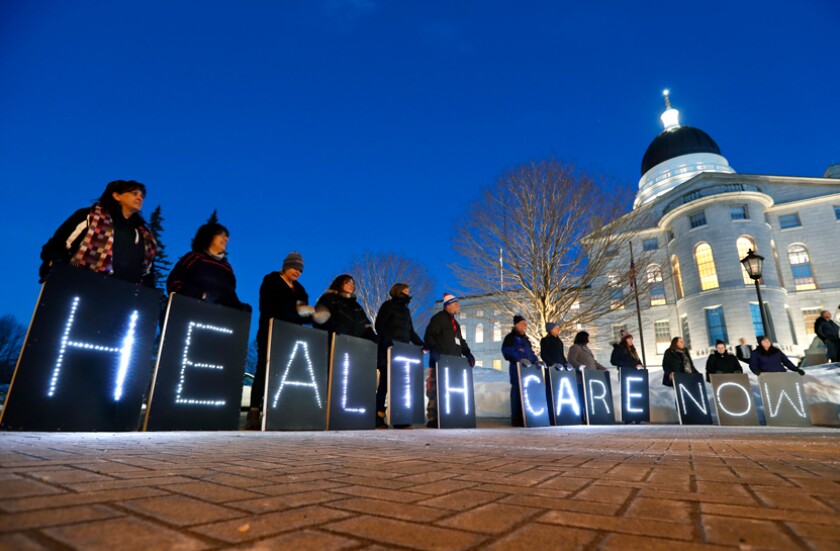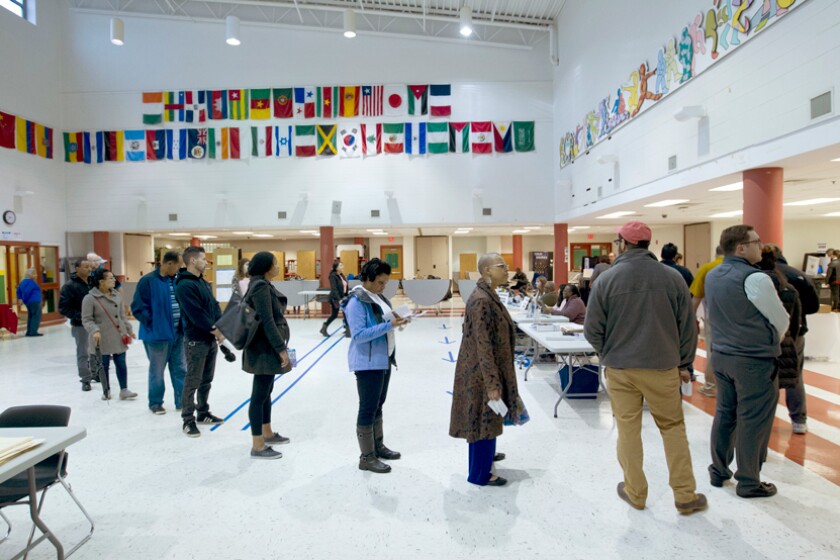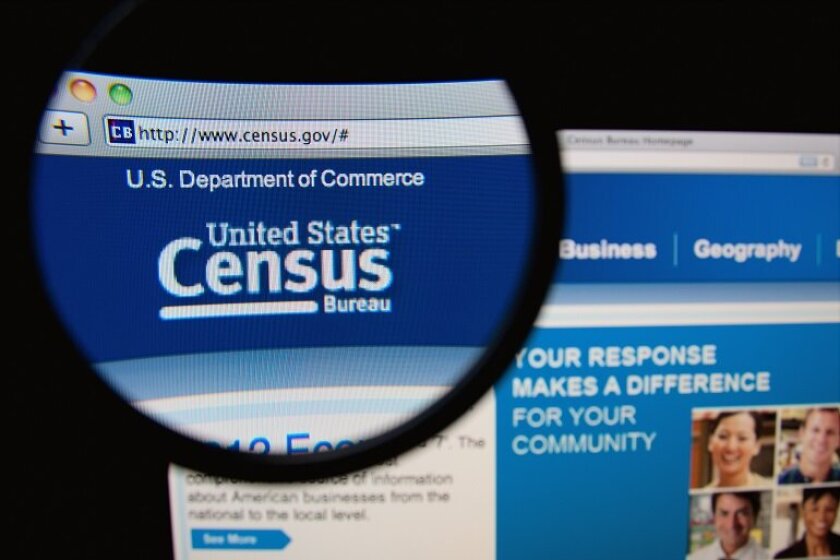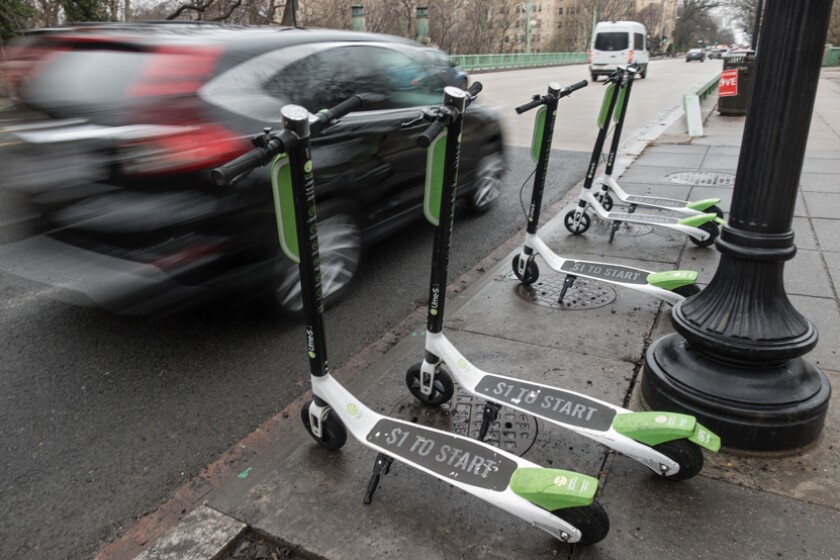MEDICAID

(AP)
Though the landscape of Medicaid keeps changing, access to more health care seems certain in at least five states this year.
Four of the states that will expand Medicaid in 2019 decided to do so at the ballot box. Last fall, voters in Idaho, Nebraska and Utah approved Medicaid expansion. Mainers voted to expand access in 2017, but outgoing GOP Gov. Paul LePage blocked it, arguing that the funding wasn’t in place. Now that Democrat Janet Mills is the incoming governor, it seems inevitable that Maine will move forward.
The fifth state that will expand Medicaid is Virginia. Lawmakers reached a compromise to expand Medicaid with a work requirement last year.
Other states that may consider expansion in 2019 include Kansas and Montana. Kansas came close to expanding Medicaid back in 2016, when then-Gov. Sam Brownback vetoed an expansion bill. The legislature wasn’t able to override the veto, but with Democrat Laura Kelly now in the governor’s office, it is probable that Medicaid expansion will get a second look this year.
The one state to limit Medicaid expansion at the ballot box was Montana. It expanded Medicaid in 2015, but the law is set to sunset in June. November’s ballot measure proposed funding the state’s share of expansion by raising cigarette taxes, which was fought fiercely by tobacco interests. The legislature is now expected to decide the expansion’s fate. —Mattie Quinn
TAX REFORM

(AP)
Thanks in large part to 2017’s federal tax overhaul, state income tax collections soared in 2018. But the big unknown for lawmakers and budget directors this year is how much of that revenue bump can be relied on going forward.
Two forces resulted in unprecedented growth in income tax revenue, which swelled by 69 percent year-over-year in December 2017. The first was high-income earners and small businesses who held off on declaring what income they could from 2016 and 2017 in anticipation of an income tax cut last year. They got it, but it wasn’t as big as expected. The other force was taxpayers in high-tax states rushing to pre-file their 2018 taxes before the $10,000 cap on state and local tax deductions went into effect.
There’s evidence that some of that initial revenue bump will carry forward, as income tax revenues have continued to outpace expectations. During the first three months of 2018, for instance, income tax collections increased in 38 states, with 23 of them reporting double-digit growth, according to research by the Urban Institute’s Lucy Dadayan.
But whether the revenue bump continues is really up to the states. Thanks to the overhaul, fewer dollars are subject to the state and local tax deduction. That will result in more income taxed at the federal level and higher overall tax bills. In at least 19 states, taxpayers who itemize have deductions that total more than the $10,000 cap. This includes traditionally high-tax blue states such as California, Connecticut, New Jersey and New York and more conservative states such as Nebraska, Ohio and Wisconsin. That will create more pressure than ever on lawmakers to fix the problem, says Rudy Salo, a public finance attorney at Nixon Peabody. “The vast majority of the country,” he says, “is going to feel the pain come April.”
Last year, Connecticut, New Jersey and New York created workarounds allowing taxpayers to fully deduct their state and local taxes, but the Internal Revenue Service issued regulations aimed at ending those loopholes.
Still, states have other policy options available. New York, in fact, has already enacted one involving a new payroll tax. But it’s a hard sell because it’s complicated to execute. So far, less than 0.1 percent of the state’s employers have taken it up. That could change this year as more taxpayers realize the full effect of tax reform. —Liz Farmer
PAID SICK LEAVE

(AP)
Issues around workplace fairness have been gaining bipartisan steam in recent years, and 2019 looks to expand on those issues.
Minimum-wage increases, laws barring pregnancy discrimination and paid sick leave laws have all been popular issues for both lawmakers and voters. Ten states and the District of Columbia currently have some paid sick leave law on the books, and the majority of those laws were enacted in the past four years. Michigan in September became the 11th state to mandate paid sick leave, but a bill passed by lawmakers last month loosens those requirements. Progressive groups have said they’ll put the issue to voters later this year, joining Maine, which has a paid sick leave initiative slated for the ballot. —Mattie Quinn
MARIJUANA

(AP)
Marijuana continues its march toward legalization through ballot measures, and lawmakers in other states, including Connecticut, New Jersey and New York, may soon follow.
Vermont last year became the first state to pass a partial legalization bill in the legislature, and others may soon follow in Connecticut, New Jersey and New York, among other states. Delaware passed a legalization bill in 2018 as well, but it fell short of the supermajority it needed. Lawmakers are expected to try again this year.
Meanwhile, medical marijuana is legal in 33 states. South Carolina, Texas and Virginia may consider legislation legalizing it in 2019. “We are increasingly cautiously optimistic that it’s going to be a pretty banner year for marijuana at the state level,” says Justin Strekal, political director for NORML, a nonprofit advocating for legal marijuana. —Alan Greenblatt
EDUCATION FUNDING

(Shutterstock)
Last year was a good year for education funding. Expect that momentum to carry into 2019.
After years of cuts and underfunding following the Great Recession, the frustration culminated last spring in widescale teacher strikes and walkouts in six states. The demonstrations yielded results: Oklahoma lawmakers passed the state’s first tax hike in nearly 30 years, which will be used to boost teacher salaries; Arizona promised a 20 percent pay raise over three years; and West Virginia teachers earned a 5 percent pay raise.
Now, thanks to the heightened awareness and shifts in political power following the midterms, more action is likely on the way. For starters, 47 frustrated teachers and educators ran for office and won last year. Among them was Democrat Tony Evers, Wisconsin’s superintendent of public instruction. He defeated two-term Republican Gov. Scott Walker.
Elsewhere, many gubernatorial candidates made school funding a key talking point. Georgia Gov.-elect Brian Kemp, a Republican, proposed giving public school teachers a $5,000 pay raise. Illinois Gov.-elect J.B. Pritzker, a Democrat, campaigned on a progressive income tax platform that he says would free up more funding for schools. And New Mexico Gov. Michelle Lujan Grisham, a Democrat, promised during her campaign to increase access to prekindergarten programs and find better ways to test students’ skills. “The teacher protests really caught on and changed the conversation,” says Michael Leachman, senior director of state fiscal research for the left-leaning Center on Budget and Policy Priorities. “You’ve really seen the shift in political dynamics around this issue.”
But momentum is one thing and finding the money another. One bright spot is that states will have new revenue streams at their disposal thanks to legal wins allowing them to collect online sales taxes and to institute sports betting. Michael Griffth, a school finance expert at the Education Commission of the States, cautions that earmarking new sin tax revenues for education isn’t all it’s cracked up to be. Often, he says, that new money isn’t enough. “If you’re going to go and spend your political capital, you want to make sure it will actually pay for the things you need.”
That dilemma is likely to lead to more teacher walkouts in 2019. In fact, the first one is already scheduled: Virginia public teachers plan to march on their state Capitol on Jan. 28. —Liz Farmer
VOTING

(AP)
Voting has become one of the most polarizing issues in the country. That will continue in 2019, with red and blue states moving in opposite directions on voting rights.
Building on the momentum from the passage of a Florida ballot measure in November to restore voting rights to former felons, Democrats in other states will push similar legislation, including in New York and Virginia, where governors have restored rights by executive order. Other states where ex-felons are still denied, such as Iowa and Kentucky, may debate the issue.
Automatic voter registration, which signs people up when they interact with departments of motor vehicles or other state agencies, has been embraced by 15 states since Oregon passed the first law in 2015. Its passage is practically a given in Democratic-controlled states where it’s not already in place, such as Maine, New Mexico and New York.
Expect lawmakers to also push for enactment of same-day registration, which is in place in some form in 18 states, or otherwise loosen deadlines for registering or switching parties ahead of elections.
On the GOP side, the focus has turned to maintenance of voter registration rolls. In June, the U.S. Supreme Court approved Ohio’s policy of removing voters who don’t respond to postcards sent by the state after they fail to vote in federal elections. GOP officials say they’re trying to prevent duplicate registrations and other potential avenues for fraud. “How data is stored is changing,” says Matt Walter, president of the Republican State Leadership Committee. “These aren’t things that reside in a state capitol anymore. They exist where foreign actors can try to infiltrate them.”
Voting rights advocates warn that the Supreme Court ruling has given a “green light” to other states to purge voters by the tens of thousands. “It’s not clear to me that they’re going to mimic the exact Ohio process, but people seeking to restrict voting will look to Ohio,” says Wendy Weiser, who directs the democracy program at the Brennan Center for Justice, which favors expansive voting rights.
As advocates on the left and right argue about voting rights and access, there’s one area of clear agreement. A bipartisan consensus has formed that many states and counties need to modernize their voting equipment, much of which has been in service since the dawn of the century. More than 40 states use machines that are no longer manufactured. How much more financial support they can expect to see from Congress remains up in the air, but the new Democratic majority in the U.S. House has signaled that voting rights will be among its top priorities. —Alan Greenblatt
BLOCKCHAIN

(Shutterstock)
In just a few short years, blockchain -- the technology underpinning bitcoin -- has gone from an obscure, futuristic concept to what many believe will be the next big technology to transform government.
Blockchain is a type of distributed ledger technology that allows multiple users to record data and transactions instantaneously in a way that is mostly unhackable. States have gone from simply trying to regulate the technology and its use in digital currency to, more recently, trying to figure out how to adopt it themselves. Delaware and Illinois have blockchain initiatives aimed at testing out the technology in land records and digital commerce; last year, West Virginia pilot-tested a blockchain platform for mobile voting in the primary elections.
The momentum is expected to continue as a number of states -- California, Connecticut, Colorado and Wyoming -- passed legislation in 2018 creating working groups aimed at evaluating the technology’s use in government and state commerce. Already in Wyoming, the state’s Blockchain Task Force has said it plans to push at least a half-dozen proposals in 2019. —Liz Farmer
MINIMUM WAGE

(AP)
Of the 23 states that have enacted minimum-wage increases since 2012 through legislation, 22 of them have been under Democratic control. That trend is likely to continue.
Democratic-controlled legislatures approved minimum-wage increases over the past two years in Illinois, New Mexico, New Jersey, Nevada and Vermont, only to have them vetoed by GOP governors. All those states, save Vermont, now have Democratic governors, including Phil Murphy of New Jersey, who says a wage hike is a priority.
But where legislators don’t act, voters will. They’ve frequently raised wages through ballot measures, most recently in November in Arkansas and Missouri. —Alan Greenblatt
ENVIRONMENTAL REGULATIONS

(Shutterstock)
From the start, the Trump administration signaled its intention to devolve many responsibilities of the Environmental Protection Agency to states and localities by loosening federal regulations. Nowhere was this more evident than with President Obama’s Clean Power Plan.
In late August, the EPA issued a new rule that allows coal plants that would have been forced into retirement under Obama’s proposal to instead continue operating indefinitely, with only relatively modest modifications. But many states have pushed back, attempting to hold the line on environmental protections. “California has been a leader on that, but we’ve also seen efforts in Illinois, New Jersey and New York,” says Jen Hensley, director of state lobbying and advocacy at the Sierra Club.
Still, states such as Arizona, Florida and Texas may continue to roll back regulations on coal plants.
Another area where this battle to loosen or shore up regulations will play out is around methane. President Trump overturned an Obama-era rule that forced energy companies to capture the gas. Several state attorneys general sued the administration in response, but some states may take up legislation to try to restrict its release. —Graham Vyse
CENSUS

(Shutterstock)
With the 2020 Census quickly approaching, 2019 is pivotal for preparation efforts. Some states, however, are much further along than others.
States typically establish, either via legislation or executive orders, what are known as Complete Count Committees that organize Census support activities and raise public awareness. Most states had yet to do so as of last month, including Florida, Texas and other large states that have seen sizable population shifts in recent years. Executive branch turnover, at least in part, held up planning and preparation in some states. Census consultant Terri Ann Lowenthal says she expects organizing to accelerate now that the midterms are over and newly elected governors are taking office.
In the past, states have also allocated money to augment federal funding for enumeration activities and outreach. At least eight state legislatures have committed dollars so far, according to the National Conference of State Legislatures. Whereas some states have appropriated small funds to hire only a few coordinators, others have set aside hefty amounts. California, for instance, has budgeted $90 million for it. That’s a big change from a decade ago when it only ponied up a few million for outreach.
The increase is partially a response to the current political environment. Many fear a potential citizenship question pushed for by the Trump administration could lead immigrants to opt not to respond to the Census, potentially resulting in a vast undercount. Census counts carry major ramifications, guiding billions in annual federal funding and allocating House seats. Population projections suggest Alabama, Illinois, Michigan, Minnesota, New York, Ohio, Pennsylvania, Rhode Island and West Virginia are all in danger of losing a House seat. That could be a “motivator for some states that are on the bubble,” says Todd Graham, who chairs the national Census State Data Centers network.
One state that could soon set aside a sizable sum of money is New York. A coalition of advocacy groups has called on the state to contribute $40 million and plans to lobby lawmakers. An Arizona House bill allocating $2 million will be reintroduced this year, while lawmakers in other states have sponsored similar proposals. —Mike Maciag
E-SCOOTERS

(Shutterstock)
When most legislatures met last year, electric scooters were something of a novelty, a quirky toy perhaps, but hardly a matter of concern for traffic cops, much less state lawmakers. Now, though, venture-capital-backed companies have introduced fleets of rental scooters in nearly 100 U.S. cities.
The quick proliferation means that state and local officials have had to scramble to address all sorts of concerns about scooters: Do they belong on the street, sidewalk or bike lane? What safety regulations should apply to them? Should riders be required to wear helmets? Should they have a speed limit? Should they even be allowed at all?
It’s likely state lawmakers will start answering those questions in the coming year. —Daniel C. Vock
UNION PROTECTIONS

(AP)
Last year was a momentous one for both labor unions and their foes, but it left a lot of unfinished business that could demand legislators’ attention in 2019.
The biggest development came from the Supreme Court, which ruled that states couldn’t force their non-union employees to pay “fair share fees” to cover the costs of union services such as collective bargaining and arbitration. In a 5-4 decision, the justices ruled that the fees violated the free speech rights of public employees.
The decision affects government workers in 22 states, which tend to skew liberal and don’t have right-to-work laws. Many of those states have already tried to soften the blow of the Supreme Court’s decision in Janus v. AFSCME by making it difficult for government employees to opt out of paying agency fees. California, Maryland and Washington state explicitly give unions permission to explain the advantages of membership during employees’ orientations. California, New Jersey and Washington also prohibit government officials from discouraging workers from joining unions.
More states could follow suit. Massachusetts lawmakers, for example, ran out of time last year to come up with a “Janus fix.” One proposal they were working on would have allowed unions to charge non-members directly for services they provide, such as grievances and arbitration hearings.
Meanwhile, conservative groups are working to enforce the ruling. The Liberty Justice Center, the group that represented the plaintiff in the Janus case, sent cease-and-desist orders to 11 states last year demanding that they allow workers to opt out of paying agency fees immediately. Two teachers sued New Jersey’s governor and the state’s largest teachers union to challenge a new state law that only allows public employees to “opt out” of paying agency fees during a 10-day window on the anniversary of their hiring.
Other conservative groups, such as the Nevada Policy Research Institute, are looking to further chip away at public unions’ power. They want unions to be recertified periodically, meaning workers would have to vote to keep their current unions every few years. They are also calling for workers to be able to represent themselves in contract negotiations.
But 2018 also saw public employees flex their muscles in states where they don’t have nearly as much power on paper. Teachers in six states went on strike to demand better pay and classroom conditions. A union-sponsored ballot measure overturned Missouri’s new right-to-work law, which had been passed by Republican lawmakers. Two-thirds of voters in the August election rejected the law. And labor groups helped to defeat two of the staunchest opponents of public-sector unions in the November gubernatorial elections: Republicans Scott Walker of Wisconsin and Bruce Rauner of Illinois.
Taken together, the results mean that both sides of the union debate are galvanized, and further fights are likely to emerge. —Daniel C. Vock
WORK REQUIREMENTS

(AP)
In an effort to undermine the Affordable Care Act, U.S. House Speaker Paul Ryan tried a couple of years ago to add work requirements in one of Congress’ many efforts to dismantle the program. But while he failed at the federal level, states have been more successful at requiring people to work to receive benefits.
Only Arkansas rolled out work requirements in 2018 -- and the PR wasn’t great. More than 12,000 people have lost coverage, with many claiming that they either didn’t know about the new work requirement or got lost in the bureaucracy of trying to report their work hours.
Starting this month, Indiana and New Hampshire are set to phase in work requirements for Medicaid beneficiaries. Both states have a variety of rules and exemptions, with New Hampshire requiring people to work or volunteer 100 hours per month, and Indiana only requiring 20 hours total. Indiana’s changes will also be rolled out more slowly, with a six-month grace period before people start losing insurance, while New Hampshire beneficiaries will only have two months to comply. “The complexities of all of these different rules make even my head spin,” says Jennifer Wagner, policy analyst for the left-leaning Center on Budget and Policy Priorities. “So even when you have guardrails in place, people don’t know about them and don’t take advantage of them.”
Although Kentucky was the first state to get work requirements approved last January, they were swiftly struck down by a federal judge, who sent them back to the Centers for Medicare and Medicaid Services (CMS) for review. But the federal government doubled down and reapproved Kentucky’s request, now set to be implemented starting in April.
With the November elections giving Republicans full control in 23 states, conservatives are certain to continue pursuing work requirements this year. Nine states have pending work requirement waivers before CMS, including Alabama, Kansas, Mississippi and South Dakota. Lawmakers in Wisconsin, whose waiver has been approved, voted last month to move forward with phasing them in next year.
Republicans argue that work requirements are a ladder out of poverty. In her letter approving Wisconsin’s work requirements, CMS Administrator Seema Verma issued a harsh statement to critics. “I recognize that there are people who disagree with this approach,” she wrote, adding that CMS believes work requirements “help lift individuals out of the shadows of opportunity and into its light.” —Mattie Quinn
ROAD FUNDING

(AP)
“People sent a very clear message,” Gretchen Whitmer, Michigan’s new Democratic governor, said on Election Night. “They want us to fix the damn roads.”
Whitmer used the slightly salty slogan as a rallying cry during her campaign. She didn’t specify how Michigan would raise the roughly $2 billion needed in new state revenue. But any idea she eventually proposes would need to pass a Republican-led legislature to become law, and GOP lawmakers have been reluctant in recent years to raise taxes.
Still, Whitmer is one of several newly elected governors talking about the need to raise money for infrastructure improvements. That, combined with the fact that lawmakers are more likely to raise transportation-related taxes in non-election years, could make 2019 a big year for boosting state transportation budgets.
Minnesota Gov.-elect Tim Walz plans to include a 10-cent-per-gallon gas tax hike in his first budget proposal, while Connecticut’s incoming governor, Ned Lamont, wants to start tolling trucks to raise revenue for infrastructure. Colorado lawmakers will decide how to respond to the failure of two transportation-related ballot measures last fall, and whether to include Gov.-elect Jared Polis’ plans for commuter rail along the Front Range in a new transportation package. Other states that could take up transportation funding include Alabama, Illinois, Georgia, Massachusetts, New Mexico, Ohio and Wisconsin. —Daniel C. Vock
GUNS

(AP)
The epidemic of gun violence in America once again captured the nation's attention in 2018, from the mass shooting that killed 17 people at Marjory Stoneman Douglas High School in Parkland, Fla., to the murder of 12 at a bar in Thousand Oaks, Calif. Despite Gallup polling showing 60 percent of Americans favor stricter gun laws, federal lawmakers took no action on the issue.
But the story was very different in the states. Twenty-two states, many with Republican governors, enacted 50 new laws restricting access to guns. Those states were California, Connecticut, Delaware, Florida, Georgia, Illinois, Kansas, Louisiana, Maryland, Massachusetts, Nebraska, New Jersey, New York, Ohio, Oklahoma, Oregon, South Dakota, Tennessee, Utah, Vermont, Washington and Wisconsin. The laws ranged from banning bump stocks to allowing authorities to temporarily disarm potentially violent people.
In addition, Washington state voters approved a comprehensive gun control ballot measure in November, restricting access to semi-automatic rifles, imposing gun storage requirements, and strengthening background checks and waiting periods.
Now states are poised to take further action. Several, including Minnesota, New York and Pennsylvania, are considering "red flag" laws, which allow families and the police to seek court orders temporarily restricting the gun access of people who may be dangerous. (Florida enacted this policy with bipartisan support after the Parkland shooting.) Nevada lawmakers are weighing a ban on bump stocks and high-capacity magazines, as well as new means of implementing the state's voter-approved background check law.
Elsewhere, gun rights advocates have had reason to cheer. Seven states expanded access to guns in 2018, according to Stateline. In Iowa, the legislature recently approved a resolution to enshrine the "right to bear arms" in the state constitution. The state House and Senate must now pass the measure a second time, either this year or next, at which point Iowa voters can vote on a constitutional amendment. —Graham Vyse
TAXING OPIOIDS

(Shutterstock)
Governments are still trying to get a handle on just how many ways the opioid crisis has affected their budgets. But what they do know is that costs are mounting exponentially. As a result, many states are looking at ways to tax opioids to help pay for the crisis now.
Last year, New York was the only successful state among a dozen that tried to pass a new tax on pharmaceuticals. Such efforts face major headwinds from the industry. For instance, a penny-a-pill tax in Minnesota last year appeared headed toward easy passage until heavy lobbying by the Pharmaceutical Research and Manufacturers of America killed the bill.
Lawmakers in Minnesota, as well as in California, Delaware, Iowa, Kentucky, Maine, Massachusetts, Montana, New Jersey, Tennessee and Vermont, all say they plan to take up legislation in 2019 taxing Big Pharma for its role in the crisis. —Liz Farmer
ABORTION

(AP)
Many abortion opponents saw President Trump’s election as a key victory in ongoing efforts to scale back access provided under Roe v. Wade. And in 2019, the landscape couldn’t look better for those abortion foes.
With the retirement of Justice Anthony Kennedy from the Supreme Court in 2018, and the subsequent confirmation of Brett Kavanaugh, the court is now more conservative than it’s been in recent memory. “We’re looking at about a dozen abortion cases making their way through the courts where the outcome could upend Roe,” says Elizabeth Nash, state policy expert for the Guttmacher Institute, a research organization that supports abortion access. With Kavanaugh’s appointment, she says, “I think it’ll up the ante.”
Indeed, conservative-leaning states are expected to test the boundaries on what abortion restrictions the courts will allow in 2019. At the same time, more progressive-leaning states are expected to pass laws codifying access to reproductive health care.
Nineteen states enacted 63 restrictions on abortion in 2017 -- the most since 2013 -- according to the Guttmacher Institute. And in 2018, two abortion measures passed that are currently tied up in court: an Iowa bill that bans abortion as soon as a heartbeat is detected and a ban on abortions past 15 weeks in Mississippi. A heartbeat bill was expected to be approved by Ohio lawmakers last month.
Opponents of abortion rights have also seen success at the ballot box. In November, two anti-abortion measures passed, with Alabama and West Virginia voting to criminalize abortion in the event that Roe is repealed or gutted in the courts. While both are mostly unenforceable right now, West Virginia’s ballot measure does end abortion coverage for Medicaid beneficiaries, and Alabama’s recognizes the “sanctity of unborn life and the rights of unborn children, including the right to life” in its state constitution.
Meanwhile, several left-leaning states are working to repeal anti-abortion laws on the books. Lawmakers in New Mexico are expected to take up legislation to remove the state’s pre-Roe ban on abortion, and New York legislators may vote on its pre-Roe law that bans abortion past 24 weeks. —Mattie Quinn
COLLEGE TUITION

(Shutterstock)
In 2014, Republican Tennessee Gov. Bill Haslam reshaped higher education in his state when he made community college free for all graduating high school students. The program, Tennessee Promise, increased freshman enrollment 13 percent in its first three years.
Haslam just wanted to make his state more competitive, but the idea kicked off a national movement. Not long after its launch, California, New York, Oregon and Rhode Island pursued similar programs to either erase or lower the cost of secondary education. And prominent national liberals, such as former President Barack Obama and Vermont Sen. Bernie Sanders, made free college tuition a talking point.
That momentum is expected to carry into 2019, with blue states in particular looking to pass legislation that increases access to higher education. Virginia, for instance, wants to legalize sports betting and use the proceeds to lower the cost of tuition at Virginia community colleges. Already, the state has plans to invest $1 billion in the Virginia Tech Innovation Campus, which has been envisioned as a tech hub that will not only feed Amazon with talent but also attract more tech firms.
A major hurdle to passing any legislation is figuring out how to pay for it. Louisiana has one of the oldest tuition assistance programs in the nation, the Taylor Opportunity Program for Students (TOPS), which was launched in 1998. The program pays tuition, and in some cases an additional stipend, for high-achieving students who attend any public college in the state. But two plans to expand the program last year were rejected. TOPS has been the victim of budget cuts for years; the program was cut by 30 percent in 2016. Lawmakers are expected to take a long look at the program and funding this spring.
States are also looking to improve access by bringing more four-year degree programs to community colleges. Currently, 19 states allow community colleges to grant bachelor’s degrees, and another dozen may take up such legislation in 2019. Last fall, California lawmakers extended a pilot program that allows more than a dozen community colleges in the state to offer bachelor’s degrees. —J. Brian Charles










